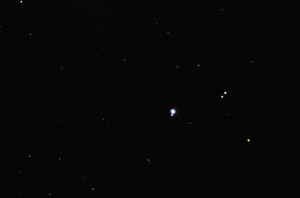This isn’t an observing update, rather, a observation update. I read an article recently about observing styles, people who plan what to see, and others who just rock the ‘scope out, and view what and where they want.
I am very much of the former. I’ll sit with my atlases (need! more! atlases!) and my pad and pencil, and decide what I want to tackle. A few objects a night, generally. Although if there are guests, I tend to do the ‘introductory Grand Tour’, which is Albireo, M92, M13, the double cluster of NGCs 869/884, eta Lyrae, Mizar, the Ring/Dumbell nebulae as starters.
As for using the actual telescope, I’ve gotten better at alignment. Polar aligning is key, but luckily not hard. In fact, I can set up in daylight, and only be a few degrees off Polaris, only having to nudge the mount a little. My favoured alignment stars are Arcturus and Dubhe, with Vega and Albireo for calibration. Then we are set for the night, the mount can pretty much do the rest. I was…sceptical of GOTO mounts, but in the end, it saves me time, and saving time there means more at the eyepiece. For some objects, I have to plug the RA/dec in by hand, and the mount gets close, but some nudging by me is still needed. Depends on the accuracy of the catalogue I am using. Did I mention I need more atlases? Well, more catalogues as well please!
A brief aside, I’ve been more than happy with the service I got from Tring Astro, both during the buying and after, and now I buy all my bits from there. A filter is on its way to me, OIII, for nebulae.
And it turns out I much prefer visual observing. Which I am both surprised and not at. I had thought I’d get more and more into astrophotography, and while I like that, I am happy at not buying guidescopes, and CCDs. Well, not until I build my obsrevatory, anyhow. But visual observing is just…fantastic. It calms me, and I spend time on the same object, teasing out more detail, getting to know it, where it lives, and how it lives. And boy, do I love my doubles. (OK, so yes, my thesis was on double systems, but that never killed it for me 🙂
In fact, given I use Ablireo as a calibration star, that is generally the first object I settle on in an evening. It is a pretty thing, no doubt about it. The Webb Deep Sky Society double star atlas is a great thing, too.
Every night it has been clear, I have been out. I can’t wait for the winter when I don’t need to wait until midnight before it gets even close to being dark. And I can get to bed before 2am. A procession of teenagers (and older) have had the aforementioned Grand Tour, and Valerie has been out as well. The family are well aware I like doubles the best, but diffuse nebulae and clusters too. I had great fun with ‘The Blinking Nebula’ the other night, as well.
I might be getting a little obsessed, but nothing wrong with that. The planning has meant I don’t come home from work and go online, rather I pour over books and charts. And curse at cloud cover. The world is quiet here, and up there.
I’ve said it before, and I’ll say it again: There is an open invitation, come round anytime. If it is clear, I’ll be out the back. If not, we can sit inside and have coffee 🙂
